Guns and roads in southwest Rarotonga
Saturday 21 October 2023 | Written by Supplied | Published in Economy, Editorials, Environment, Features, Local, National, Opinion, Weekend
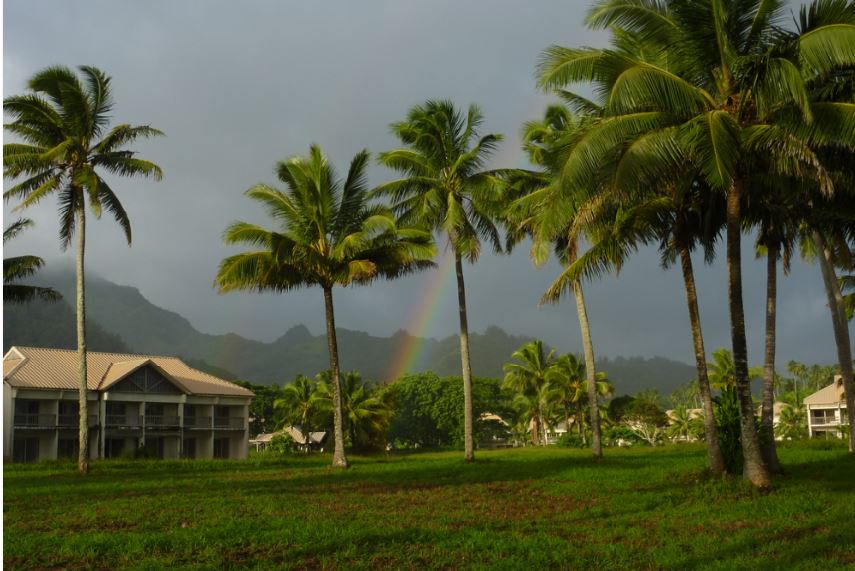
The remains of Sheraton Hotel in Vaimaanga. Photo by Brian Baudinet/ 23102035
The old deserted and controversial Sheraton Hotel in Vaimaanga is getting a new lease of life after Rarotonga businessman Chris Vaile took on the challenge to redevelop the site into a high-end apartment property complete with other amenities.
But the recent development surrounding the proposed closure of the coastal main road for a ring road around the property has been met with criticism from the public. Influential entrepreneur Brian Baudinet explains why the community should be consulted before such a major undertaking is completed.
Following an argument over ownership of the land known as Papua 4 at Vaimaanga on Sunday, March 12, 1911, More Uriatua, the leader of the rival clan that claimed to be the legitimate titleholders of the land, was shot dead by European settler William John Wigmore on the site – locally still called “The Sheraton”.
From the shooting in 1911 to the battering to death of the Italian negotiator Franco, who spearheaded the initial project, in a hotel in Vanuatu, the past history of the Sheraton/Vaimaanga Hotel site sports some pretty heavy stuff.
Lately – More Amoa, Vincent Ingram, Norman George, Geoff Henry, Terepai Maoate, Robert Woonton, Jim Marurai, Henry Puna, Sicel and the Italians, Sheraton, Hilton, Covington, Tim Tepaki around 2003 with Fletcher South Pacific, Mark Lyon, Tim Tepaki in 2017 with “hundreds of millions of dollars” in Chinese backing, Paintball, $5 access, and Mirage Group – were all involved at some stage.
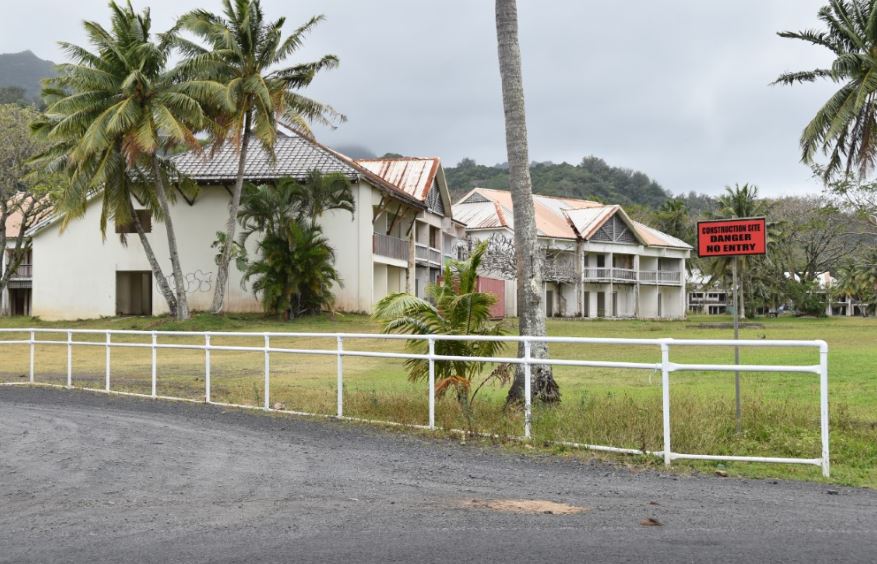
Cook Islands News earlier this month reported Rarotonga businessman Chris Vaile has plans to divert the main coastal road behind his ongoing venture at the old Sheraton site. Government has “no issues” with the plan. LOSIRENE LACANIVALU / 23100421
Also, in 1911 Metua, the daughter of More Uriatua, placed a “curse” on the land which is still in effect, and no doubt a story for another day.
The first deal on the 14.432-hectare land was signed in 1987 between the Cook Islands Government and an Italian Bank through their negotiator Franco. Then an Italian insurance company became involved, and an Italian contractor named Sicel began construction with some rusty second-hand equipment shipped from Italy. Sicel went bankrupt after the bank cut the financing and the Sheraton was about 80 per cent complete.
In the early 1990s the Cook Islands Government was left with liabilities of around $120 million, and eventually – but not without considerable pain – the debt was settled for $52 million.
Most will remember at that time the intervention of our own “1996 Financial Crisis” which resulted in 1500 staff being axed from Government positions, and a mass exodus to New Zealand and Australia followed.
As the Hotel fell into disrepair, successive governments were at fault over about 20 years for failing to find a resolution to a problem they themselves had created.
I also recall the various attempts by residents and Government agencies to protect and trade and sell many of the assets. Residents know that there are tiles laid in Aitutaki, railings in Takuvaine, and a spa bath in Mauke.
Developers came and went with the lease changing hands a few times – and only recently has Pa Ariki entered the fray because no progress was being made by Mirage for a sale, and there were too many negative stories especially in the NZ media. And the site continued to be an eyesore.
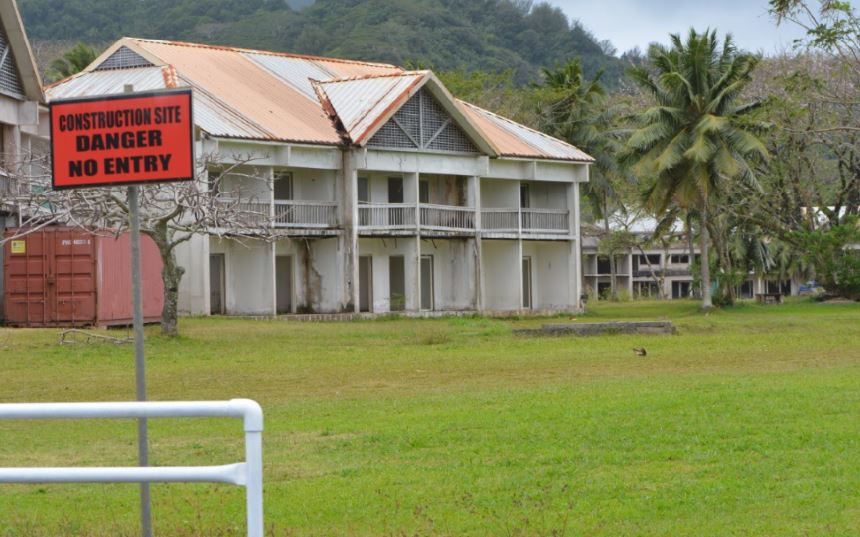
The abandoned Sheraton Hotel is being redeveloped by Rarotonga businessman Chris Vaile. The first section, which includes 41 rooms and a new swimming pool, is scheduled to be completed by the end of next month. LOSIRENE LACANIVALU / 23100417, 23100418 / 23100419/ 23100420/ 23100421 / 23100422
And at last, some action – obviously the view of the current developer is to create another Muri, with apartments and tennis courts, swimming pools, cafes, shops and plenty of parking. After negotiating a hairpin bend, and no doubt another 30kph speed limit, the traveller will be relieved to stop for a coffee, or even a water at the TTV Cafe. And to discover that the power and water will all come from renewable energy.
However, what is being created here is a horseshoe road situation, which – if it goes ahead – will no doubt be copied by other landowners. And why shouldn’t they, to improve the value of their land by having no road between them and the beach. Perhaps then we will end up with a number of horseshoes, and an ideal race-track situation for some of our growing number of bikies.
A good example of that would be the land known as Pokoinu 107 where the golf course plus tennis and volleyball courts are situated, and now commercial food caravans. This land was taken by Government Warrant around 1953 for use as a Wireless Station, so obviously the prime use has now changed. And the landowners are now raising their concerns, and talking about the land being returned so they can utilise the unused areas themselves – with existing leases retained.
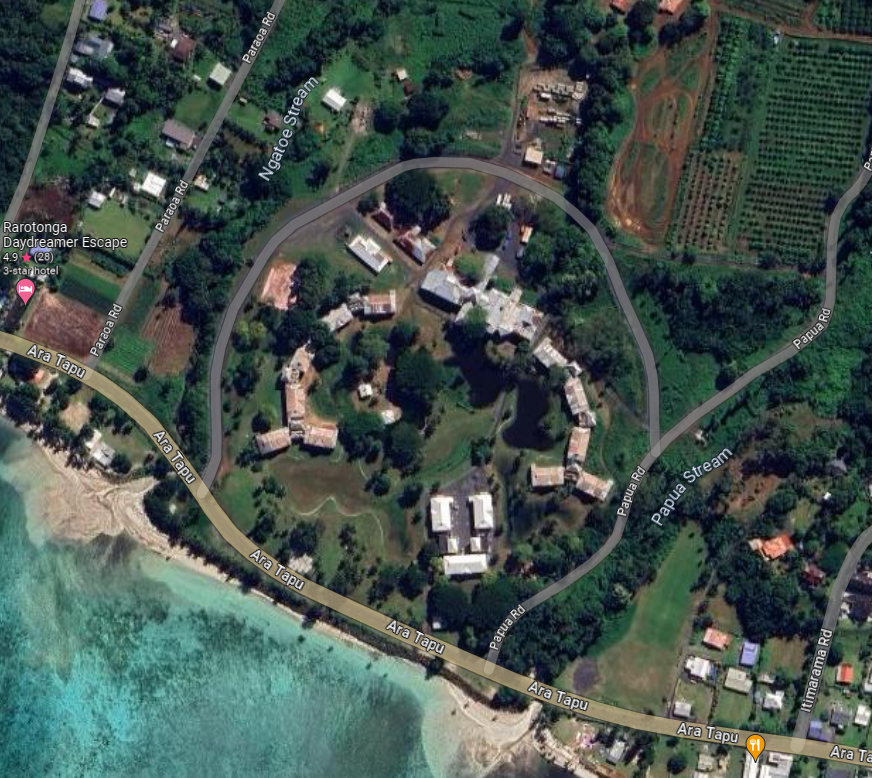
A Google Maps image showing the ring road around the abandoned Sheraton hotel, which is now being redeveloped in Vaimaanga. 23102036
Land on most of the Cook Islands can have a lot of agreements attached to it, and this Vaimaanga site is no exception.
But putting all those aside, in this situation the Government needs to decide what is “practical”. Clearly a road around the rear of the site creating a horseshoe is not practical.
The Government has said it is happy with a new horseshoe road, but continuing with the current road along the beachside seems to be the view of the majority of the population so far.
Perhaps a referendum should be held, and the Government can then decide whether to take the road by Warrant or not – taking into account how this position my affect other areas.
Also read:
> Sheraton redevelopment steps up, road closure on the horizon
> Letter: New Vaimaanga development
> Letter: Sheraton redevelopment
> Reflecting on the Sheraton development
Taking the road by Warrant would involve compensation, but the question is how much.
My understanding is that for a new Lease, the current Leaseholder has paid $50,000 to Pa Ariki, and $150,000 to the previous Leaseholder, along with some guarantees as to completion of “development”.
This is very admirable, and it is great to see the progress and the eyesore being currently reconstructed.
But another major factor has to be taken into account – and that is the fact that the Government has recently spent (Infrastructure Cook Islands please tell us) probably up to $1 million on a huge rock wall on the beachfront of the property. (ICI Secretary Elizabeth Wright-Koteka told Cook Islands News: “ICI implemented foreshore protection on the Vaimaanga foreshore at the Sheraton area, as well as the Rutaki foreshore. This project was done in phases over the 2018/19 and 2020/21 financial years, covering an area of 670 metres. The overall costs for both Sheraton and Rutaki foreshore project was $1.4 million.”) This can be clearly seen on the front page of the ICI website at https://ici.gov.ck/ which also includes some Ngatoe Stream work. This has added considerable value to the land, and surely would be adequate compensation for taking the road by Government Warrant.
If the road was taken by Warrant, beach access is still possible by (as now) crossing the road just like visitors at other properties must do. Or beach access can be included in any agreement, either under the road by tunnel or over the top by bridge – just like in other countries.
Another question here – if the road was changed to the horseshoe, what happens to the current power and water and internet lines? That surely would be a huge cost to move all around the back, and who would pay for it?
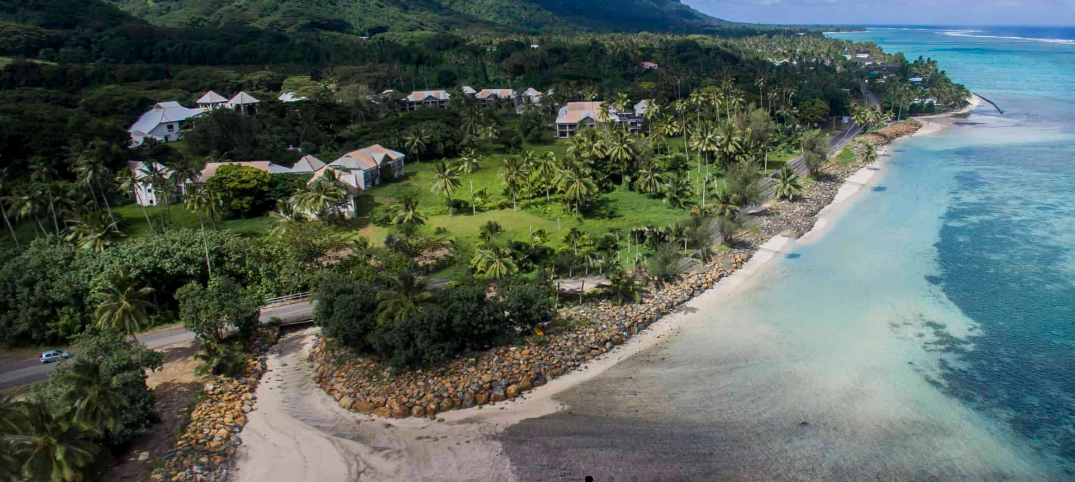
Coastal improvements work done by the Government to the tune of $1.4 million. SUPPLIED/23102034
Here is a flashback –
CI News 13 January 2004
Stop the road
Dear
Editor,
The concerns of the Cook Island public with respect to the new Captain Cook
Hotel proposed on Pa's land in Takitumu need to be explained and aired publicly
- before the process of the EIA approval is finalised.
Another matter of principle concern is the disadvantage the developers intend
to force upon the people of Rarotonga and the Cook Islands by changing a public
road, introducing two dangerous corners and by an extended detour require the
people to travel a greater distance around their hotel and our island.
This is unprecedented and no one on this island has that right, not even the
government, who are not landowners. Our customs and traditions dictate that
action, and the wise course would be to let the people of this island have
their say on this matter before any confirmation of this EIA.
Were a precedent set on this matter, it could mean that any foreign lease
holder could change the direction of a public road to suit their interests, to
the detriment of the travelling public.
If the government were to do this, they would come under the greatest scrutiny
and we would want to know who was responsible and from what island. No public
meeting has been scheduled to determine agreement on these matters either with
the public or our government and the developer. This is precisely the aim of
hearings on the EIA and is the principal purpose of an EIA report. It would be
wise for the government to make this process transparent if it intends to remain
in our favour. I write in support of Bill Rennie's submission to the
Environment Service.
Eruera Nia,
Taputapuatea
And is there still a question of who owns the land?
Currently the landowner is Pa Ariki, but to quote the words to me of one of our first Land Court stalwarts Judge Jock MacAuley on 19 July 2000: “Pa Ariki is not the true owner of the Vaimaanga land, although the title shows her name as title holder. When the courts first commenced on Raro', Wigmore and a European Doctor (Craig?) wanted to lease the land as it would be NZ’s garden in the winter times. There were several families planting the land and Wigmore promised them jobs as paid labour. The Judge at the time thought the best way out of a long drawn court session to prove ownership, was to title it as Ariki Land. When Pa was asked to lease to the Government in the 1980s, I told Mike Mitchell that she cannot give a 60-year lease without the consent of the Ui Ariki. Mitchell insisted that she had a “Freehold” title and could lease to Government. I still insist that it was wrong both in fact and in law. However, Marie (Pa Ariki) would be pleased to see someone take over, as the Government has failed in rental payments.”
Also, a good read is Lily Kairangi Henderson’s letter to the Cook Islands News published on 11 December 2003 regarding ‘Title Lands’.
Good on you Chis Vaile for taking up the challenge of an abandoned eyesore, no matter all of the faults of the past. And good luck to all the participants.
But in my view, there should be a lot more discussion and consultation, before the existing road is closed to traffic.
For example, neither lawyers Tina Browne nor Tim Arnold (for Pa Ariki) has explained the parameters of the new road, and who will actually own it. I thank Browne for her explanation of the Lease published in the Cook Islands News on 18 October 2023, however what should be considered is what is best for everyone, and not for just a few.
The landowners and leaseholders can do whatever they like with their land, but here I think the community should be consulted before such a major undertaking is completed, which will affect everyone.
And consideration given to the future disruption to people’s lives, on this site and others.
- Brian Baudinet is a highly accomplished and influential entrepreneur with a diverse portfolio of businesses in the Cook Islands and New Zealand. The views expressed in this article are his and do not necessarily reflect the views of this newspaper.




































